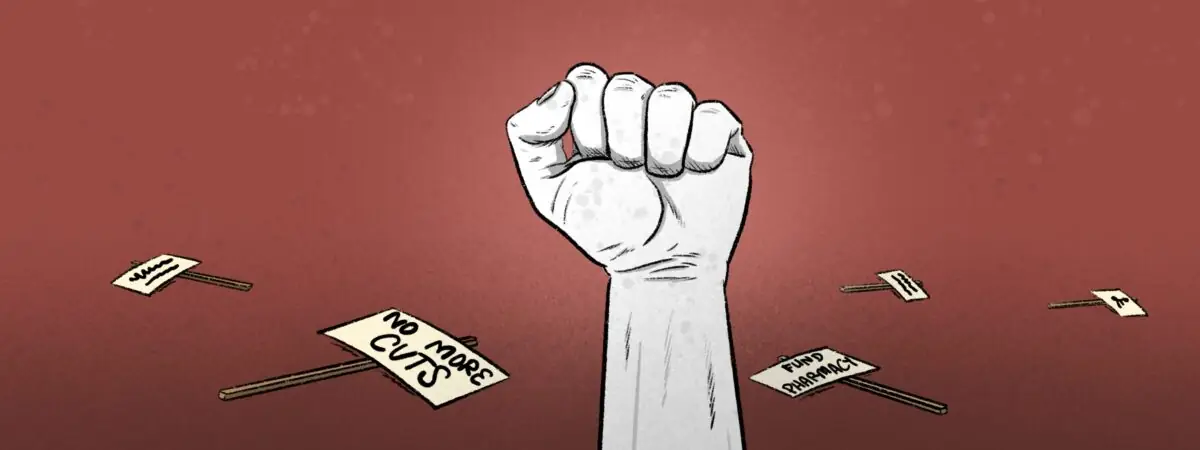Speaking at The Pharmacy Show in Birmingham on 13 October 2024, Paul Rees, chief executive of the National Pharmacy Association (NPA), highlighted the importance of unity when it comes to influencing the government and policy makers.
“Unity is key,” he said, adding that “it’s only unified sectors that get results”.
The result Rees and the rest of community pharmacy is after is more funding. Community pharmacies have been cash strapped since at least 2016, when the government imposed cuts worth £170m on the sector.
In September 2024, the NPA announced that it will ballot its 6,000 members in independent community pharmacies for the first time on whether the sector should take “work-to-rule action” in response to the funding cuts. The ballot represents an escalation in the NPA’s ongoing ‘Save our Pharmacies’ campaign, which has previously led to participating pharmacies ring bells and turn off their lights as a sign of protest against their decade-long financial struggles.
This is not the first time the suggestion of using industrial action as a bargaining tool has been floated. Community pharmacy contractors called for strike action in 2016, when the funding cuts first occurred, but the idea was quickly knocked back by Sue Sharpe, chief executive of the then Pharmaceutical Services Negotiating Committee, who highlighted at the time that a strike “would be very unwise” owing to the detrimental impact it would have on patient safety.
Staying united in the midst of industrial action will be a major hurdle to overcome
Sharpe was right to be wary. In 2009, a community pharmacy strike in Ireland was called off after 11 days when the union urged contractors to resume services “in the interests of patient safety”. News reports from the time describe long lines of patients waiting for their medicines at contingency pharmacies set up by the Health Service Executive, many of which did not have commonly prescribed medicines that patients needed.
However, patient safety may now be at risk with or without industrial action. The latest data from the NHS Business Services Authority show that the number of pharmacies in England is at an all-time low, with just 10,511 pharmacies operating following a spate of closures during and in the years after the COVID-19 pandemic. In 2023, The Pharmaceutical Journal revealed that these closures are mostly occurring in the most deprived parts of the country, impacting patients who need accessible healthcare most readily. The previous government argued that more pharmacies were closing in these areas because there are more pharmacies located in these areas.
But Janet Morrison, chief executive of Community Pharmacy England (CPE), who also spoke at The Pharmacy Show, suggested this may no longer be the case, warning that the government cannot control where a pharmacy closes. She described the sector as being at “a house of cards moment” — in an increasingly fragile state.
Instead of taking a stance alongside Sharpe, Morrison’s comments on the NPA’s ballot indicate a change in attitude toward possible action. At the time, she said the CPE was “in favour of anything” that helps to make the case for more money for community pharmacies, adding that it “will be interested to hear about the outcomes of this ballot” to inform its tactics for negotiating the new community pharmacy contract with the government.
The Company Chemists’ Association (CCA), which represents multiple pharmacies, also reacted favourably toward the prospect of action, highlighting that pharmacies “cannot be expected to deliver more and more workload within an ever-shrinking funding pot”.
While these positive remarks point towards the unity that Rees says is needed to affect change from the government in this area, staying united in the midst of industrial action will be a major hurdle to overcome.
The community pharmacy contract is set up to drive competition between contractors. Unlike GPs, who have their own lists of registered patients, pharmacies are competing with each other for business when it comes to patients choosing where to collect their medicines, where to go for a Pharmacy First consultation or a blood pressure check.
If the “work-to-rule action” does go ahead as the NPA describes — with some pharmacies withdrawing any ‘optional extras’, such as advanced services and longer opening hours — it will be independent pharmacies that will lose even more money as patients are forced to choose a competing pharmacy that offers the services they require.
Furthermore, the NPA is not a trade union, meaning that any action will only be ‘advisory’, which could mean that participation is constrained even further to a select few pharmacies that are financially able to limit their offering in such a way.
While this industrial action might not be as far reaching as the junior doctor strikes or train driver walkouts, the fact that it is being discussed at all shows that the direction of travel for community pharmacy has worrying implications for patient safety. It is now incumbent on the government to take the next step in making sure pharmacies can continue to offer the care patients need. PJ



